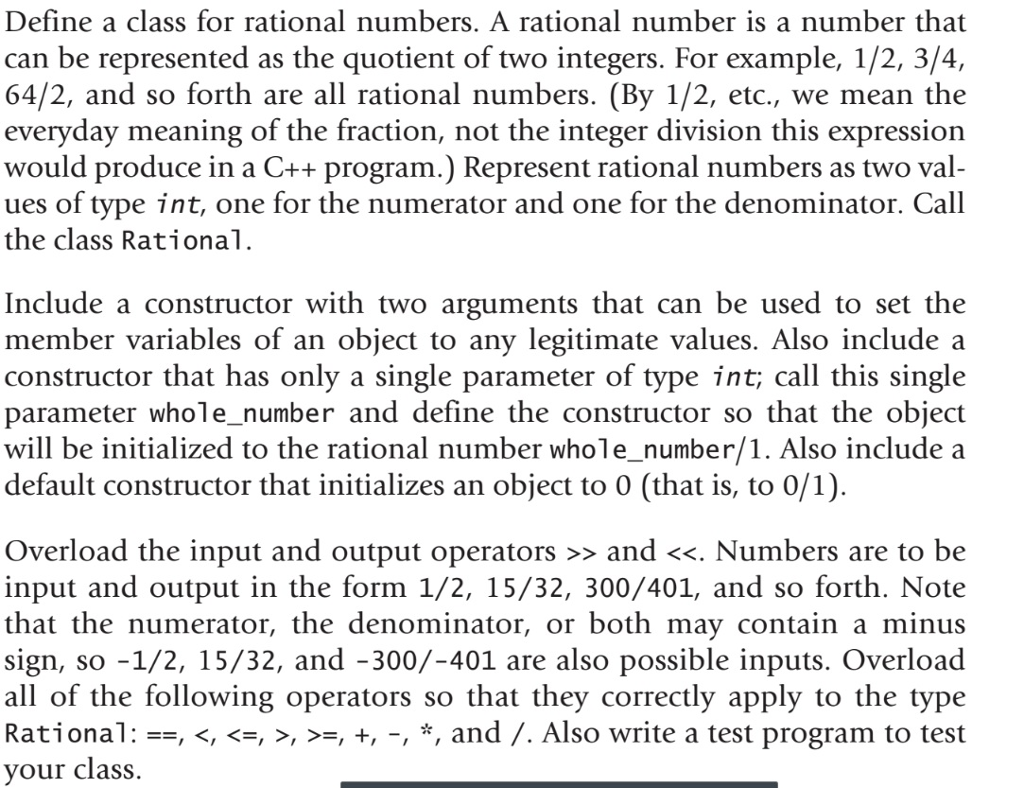Answered step by step
Verified Expert Solution
Question
1 Approved Answer
#include #include #include using namespace std; class Fraction { public: // constructor Fraction(int a, int b); // generate a fraction which is a/b Fraction(int a);
#include#include #include using namespace std; class Fraction { public: // constructor Fraction(int a, int b); // generate a fraction which is a/b Fraction(int a); // generate a fraction which is a/1 Fraction(); // generate a fraction which is 0/1. i.e 0 // member functions int get_numerator() const; // return the numerator of the fraction int get_denominator() const; // return the denominator of the fraction void reduce(); // reduce this fraction to simplest form. For instance, // 2/4 will be reduced to 1/2 Fraction reciprocal() const; // return the reciprocal of this Fraction // friend functions friend Fraction operator +(const Fraction& f1, const Fraction& f2); // return the sum of f1 and f2, // the result is reduced friend Fraction operator -(const Fraction& f1, const Fraction& f2); // return the difference of f1 and f2, // the result is reduced friend Fraction operator *(const Fraction& f1, const Fraction& f2); // return the product of f1 and f2, // the result is reduced friend Fraction operator /(const Fraction& f1, const Fraction& f2); // return the quotient of f1 and f2, // the result is reduced friend Fraction operator -(const Fraction& f); // return the negation of f friend bool operator (const Fraction& f1, const Fraction& f2); // return true if f1 is greater than f2. // False otherwise friend bool operator = (const Fraction& f1, const Fraction& f2); // return true if f1 is greater or equal to f2. // False otherwise friend bool operator == (const Fraction& f1, const Fraction& f2); // return true if f1 is equal to f2. // False otherwise friend bool operator != (const Fraction& f1, const Fraction& f2); // return true if f1 is not equal to f2. // False otherwise friend istream& operator >> (istream& in, Fraction& f); // input f in the form of a/b, where b cannot be zero. Also, // if b is negative, the Fraction will change b to be positive. // So, again, 1/-3 will be changed to -1/3 friend ostream& operator , =, > and 0) cout 1.4) cout 0) cout 1.4) cout 0) cout 2.9) cout if(f1 > f2 || !(f2 > f1) || f1 > f3) { cout operator was wrong. "; result -= 0.5; } // Test == if(f1 == f2 || !(f1 == f3) || f2 == f3) { cout = if(f1 >= f2 || !(f1 >= f3) || !(f2 >= f3)) { cout 0) cout 1.9) cout > f; if(f.get_denominator() != 4 || f.get_numerator() != -3) { cout > choice; if(choice != 'y' && choice != 'Y') { cout 0) cout 0.9) cout Define a class for rational numbers. A rational number is a number that can be represented as the quotient of two integers. For example, 1/2, 3/4 64/2, and so forth are all rational numbers. (By 1/2, etc., we mean the everyday meaning of the fraction, not the integer division this expression would produce in a C++ program.) Represent rational numbers as two val- ues of type int, one for the numerator and one for the denominator. Call the class Rational Include a constructor with two arguments that can be used to set the member variables of an object to any legitimate values. Also include a constructor that has only a single parameter of type int; call this single parameter whole_number and define the constructor so that the object will be initialized to the rational number whole_number/1. Also include a default constructor that initializes an object to 0 (that is, to 0/1). Overload the input and output operators >> and , >=, +, -, *, and I. Also write a test program to test your class
Step by Step Solution
There are 3 Steps involved in it
Step: 1

Get Instant Access to Expert-Tailored Solutions
See step-by-step solutions with expert insights and AI powered tools for academic success
Step: 2

Step: 3

Ace Your Homework with AI
Get the answers you need in no time with our AI-driven, step-by-step assistance
Get Started



